Intel NUC Kit D54250WYK
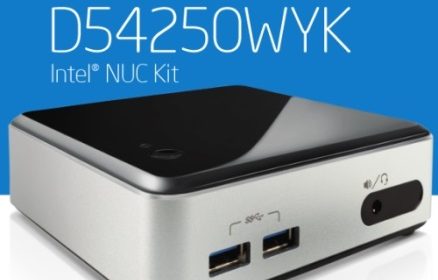
For home theater PC (HTPC) enthusiasts the news that Intel was leaving the retail motherboard market cut deeply. After all, many of the features we have come to expect, like an Intel network interface card (NIC), consumer infrared (CIR), and outstanding stability along with innovations specific to our market, such as the custom solutions (aka HTPC) header, looked likely to slowly fade away. Fortunately–at least for now–these concerns have proved meritless because the output of that decision, the Intel NUC Kit D54250WYK contains each of these features along with something that was previously unattainable to DIY – a 15W TDP integrated processor graphics (IPG). Running $342 in bulk, the cost of the 1.3-2.6GHz Intel Core i5-4250U makes up much of the $360 (estimated SRP) we expect the D54250WYK barebones to retail for. While not cheap, it certainly appears a good value if the Haswell iteration of the NUC can deliver the perfect client HTPC.
Device
Like the previous Intel NUC Kit, the Haswell update also plays the welcoming Intel jingle when exposed to light. It is a nice touch, and this time around Intel included the necessary locale specific “Mickey Mouse” (IEC 60320 C6) power cable in the kit for the US, UK and EU markets. This was an area where Intel took some heat previously so it is great that this was addressed to complete the excellent unboxing experience. It is hard not to compare the D54250WYK to the DC3217IYE when it comes to looks, and it comes away favorably. The aluminum outer shell is very nice, complementing the piano gloss top, and assisting the rest of the device in an easy bid for space in the A/V stack. Of course even if it were a little less handsome, the inclusion of a complete consumer IR (CIR) solution (i.e. the receiver sensor is also included) which supports wake from off (S5)/standby (S3) and discrete RC6 on/off codes it would still be quite natural to include the NUC. One odd thing is that the green “standby” LED is always lit when the device is not on (it is blue in S0). I expected it to annoy but in both cases the light output is so low (read: perfect) that neither was even close to offensive.
It is critical to note the inclusion of “Kit” in the D54250WYK’s naming scheme as it is a barebones system requiring, at minimum, an mSATA SSD and some 1.35v DDR3 memory. Looking at the pictures you would be forgiven for assuming that 1.5v will also work, but that is not the case–just an unfortunate bit of component sharing. Cracking the box is quite straight forward, only requiring the loosening of the four screws placed in the rubber feet on the underside of the NUC. If you are a bit more adventurous the D54250WYB motherboard can be extracted by removing the two black screws near the back and some gentle prying in that area. Do not be surprised if it takes more than a little careful effort and some outward pressure on the rear I/O shield.
Once freed from the chassis the included heatsink and fan (HSF) is the most dominant feature on the underside of the board, but it also includes Intel’s custom solutions, or HTPC, header which provides access to HDMI CEC and the REC_LED functionality. Unfortunately a more forgiving chassis with space for the Pulse-Eight internal CEC adapter is not yet available, so it was not possible to test this feature. When one does appear, we’ll be sure to grab a 2.0mm-to-2.4mm USB adapter and give it a go.
System
Specifcations
| Chassis Dimensions: | 4.59” x 4.41 ” x 1.36” (116.6mm x 112.0mm x 34.5mm) |
|---|---|
| Board Dimensions: | 4” x 4” (101.6mm x 101.6mm) |
| IPG: | Soldered-down Intel Core i5-4250U |
| Supported Memory: | 2x 204-pin DDR3 1600/1333 MHz 1.35v – 16GB Maximum |
| Chipset: | Integrated Q87 (Lynx Point) |
| Network: | Intel I218V Gigabit Ethernet Controller |
| Video: | 1x Mini HDMI 1.4a1x Mini DisplayPort 1.2 |
| Audio: | Eight channel audio via Mini HDMI 1.4a and Mini DisplayPort 1.2 Intel HD Audio via front panel audio jack (mic/headphone/speaker) |
| External: | 4x USB 3.0 (2x Front/2x Rear) 1x Mini HDMI 1.4a 1x Mini DisplayPort 1.2 1x 10/100/1000 LAN 1x Kensington Tether1x Analog Audio |
| Internal: | 1x 6.0Gbps SATA1x SATA power 1x 2.0 pitch USB 2.01x 2.0 pitch Front Panel 1x Complete CIR Solution |
| Expansion: | 1x PCIe Full-Mini (mSATA)1x PCIe Half-Mini |
Configuration
| CPU: | Intel Core i5-4250U: 1.3-2.6GHz |
|---|---|
| GPU: | Intel HD 5000: 200MHz-1GHz |
| HSF: | Included Intel NUC HSF |
| Motherboard: | Intel NUC Board D54250WYB |
| RAM: | Crucial CT51264BF160BJ 8GB (2x 4GB) DDR3 1600 1.35v (CAS11) / ADATA AXDS1600GC4G9-2 8GB (2x 4GB) DDR3 1600 1.35v (CAS9) |
| Storage: | Intel SSDMCEAW180A4 180GB SSD / Crucial M500 120GB SSD |
| PSU: | Included 65W |
| OS: | Windows 7 Ultimate 64-bit / Windows 8 Ultimate 64-bit |
| AVR: | Denon AVR-X2000 |
| Display: | ASUS VE248Q / Samsung PS51F5500 |
| Additional Components: |
Intel Dual Band Wireless-AC 7260 |
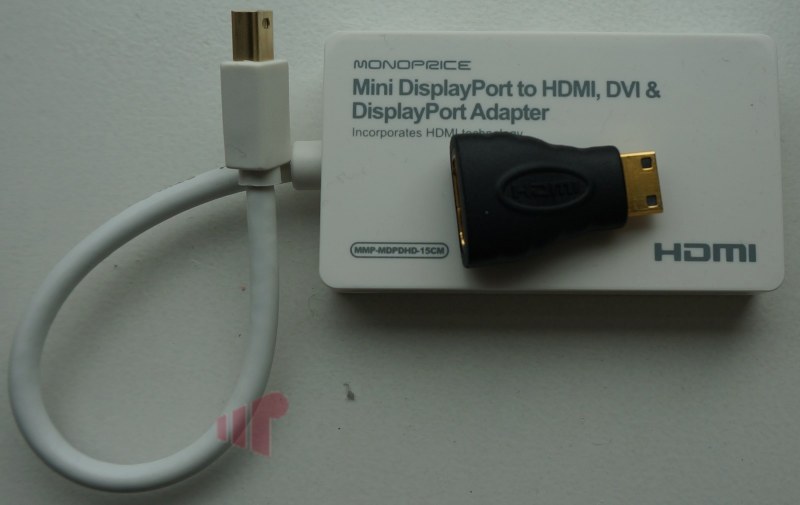
Fitting as much I/O on the rear of the Intel NUC Kit D54250WYK required some compromise, so to connect up to a display an adapter will be required. Both Mini DisplayPort and Mini HDMI were tested with the respective Mini-to-Full-Size converter.
One of the welcome differences between the previous NUC kits and the D54250WYK is the inclusion of a 6.0Gbps SATA port and the header required to power it. It should be noted that Intel did not route 12V to the SATA power connector so 3.5” devices will not spin up, but both the 2.5” HDD and slim-line Blu-ray ODD used to test the feature performed perfectly. The necessary female SATA connector is not included in the kit, but it is possible to use either a standard SATA extension with two or more heads (HDD e.g.) or hunt down the specialized cable (ODD e.g.). I hope to see HTPC chassis that can support both of these use cases in the near future.
One of the few niggles with the Intel NUC Kit D54250WYK is that its HSF can be a bit “buzzy” at times. Like most notebook HSF, its pitch is more a reminder of the NUC’s presence than an annoyance, and certainly not loud enough to be audible when the noise floor rises (e.g. people talking in the room, listening to music, watching a movie, etc.). Upon removing the stock HSF it was obvious that more thermal solution was present than really required so it was removed and reapplied (be careful not to misplace the PCH’s thermal pad). Unfortunately the results were only marginally beneficial. Hopefully this is another area where we see some 3rd party innovation towards a truly silent NUC solution.
Our BIOS is standard Intel Visual BIOS. Clear and easy to use, there was little to mess with. Oddly the TPM was not enabled by default, so if you want to use BitLocker it will require a trip inside.
Use
Getting both Windows 7 and Windows 8 installed were simple using a USB key, although even Windows 8 did not include the necessary network drivers for the Intel I218V, so make sure you have at least those handy before starting the build.
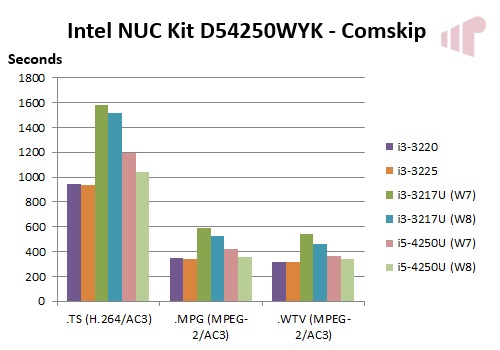
With up to 2.6GHz on tap the Intel Core i5-4250U was unsurprisingly responsive and its relative prowess proved out in the Comskip testing. Naturally it can’t quite match previous generation desktop Intel Core i3’s significantly higher clocks, but handily bested the Intel Core i3-3217U in the previous generation NUC.
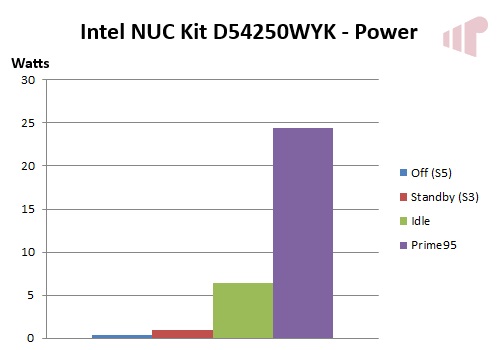
Of course desktop chips cannot even come close to the 15W Haswell’s outstanding S3 (0.9W) and idle (6.4W) power consumption. Even under load (Prime95), the Intel Core i5-4250U only consumes 24.4W.
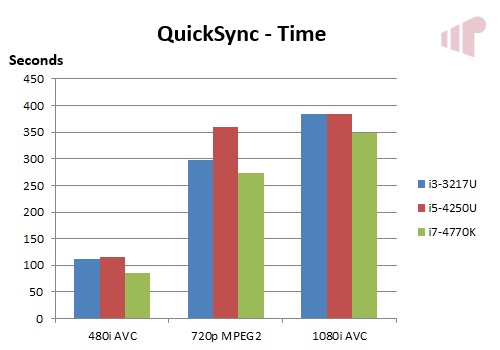
Having taken an in depth look at Haswell Intel Quick Sync performance the numbers above did not come as a huge surprise. The Intel Core i5-4250U is generally a bit slower at the same settings, than the Intel Core i3-3217U just as other we found previously, with picture quality enhancements as the trade-off.
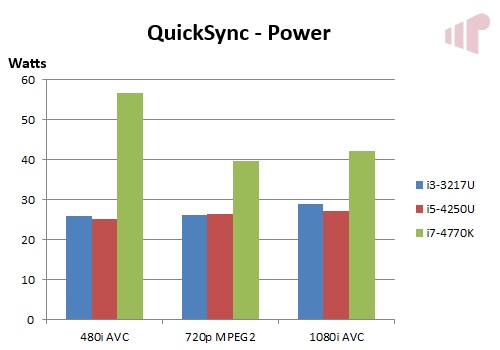
Power consumption was not included in the previous analysis, so it was interesting to see that the Intel Core i5-4250U’s Quick Sync implementation has lower power consumption on average than the lower clocked Intel Core i3-3217U.
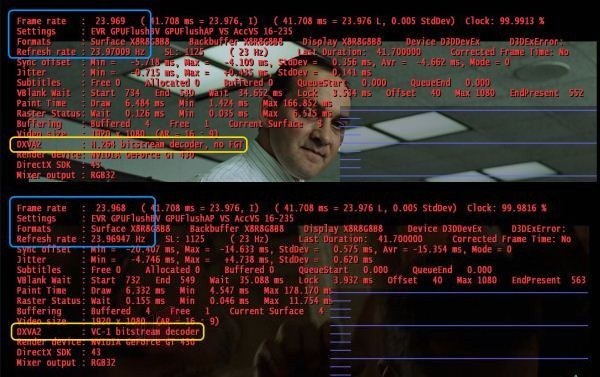
As we all know, Intel graphics have historically struggled in the area of refresh rate accuracy. This issue was put to rest with the 4th generation of Intel Core IPG and the Intel NUC Kit D54250WYK performs admirably in this area – actually the best I have ever measured. This would be meaningless if it did not also check all of the boxes we expect from a competent media solution like correct video levels, HBR audio bit streaming, and 3D Blu-ray playback, but of course it does making it one of, if not, the best all-around SFF HTPC solutions available.
That is not to say that media performance is “without compromise” however. Although more niggle than hardship, I had hoped that Intel HD 5000 graphics would be the one that finally unlocks madVR’s full potential on the Intel platform, but unfortunately that was not the case. Like the HD 4400 and HD 4600, it can handle Lanczos 3 + Anti-Ringing (AR), but that’s it; Lanczos 4 + AR and Jinc are still off limits. To be clear, this is a minor complaint but still an area where we hope to see improvement in future generations of integrated graphics.
Conclusion
It is almost painful to admit that there is so little to criticize about the Intel NUC Kit D54250WYK. Obviously it is not perfect; it would be great to have a slightly less “buzzy” cooling solution, a second SATA port, and 12V routed to the SATA power, but frankly these “cons” are insignificant compared to the features and performance delivered by this tiny barebones HTPC. All of the boxes we can usually tick on an Intel system are there: correct video levels, HBR audio bit streaming, 3D Blu-ray playback, and solid network performance alongside the refresh rate accuracy we have been waiting for, a complete CIR solution and topping that off — it is all wrapped up in a sleek chassis containing a power efficient IPG. For the budget conscious, the kit’s $360 asking price might be a bit high (there will be an Intel Core i3 and Atom version later), but at least for me it seems worth every penny. I cannot wait to see the 3rd party ecosystem evolve around this, and other NUC, products. Well done.
Pro:
- Features: Intel NIC, complete CIR, custom solutions header
- Form factor
- Price
- Media performance
- Power consumption
- Flexibility
Con:
- HSF is a bit “buzzy” at times
- Intel HD 5000 is not strong enough for madVR Jinc3 + AR
Thanks to Intel for providing the review sample.

I saw another version of NUC
I saw another version of NUC that comes with a red color top with a dragon on it. Have you looked at it? I think it only ran about $299.
http://www.legitreviews.com/intel-dc3217iyr-limited-edition-nuc-computer-now-available_122525
That’s just the DC3217IYE
That’s just the DC3217IYE (last gen i3 IVB NUC) in a fancier chassis. I agree that it looks really nice, but personally I’d much rather have the HSW NUC. There will be i3 HSW and Baytrail NUCs as well if you’re looking for something a bit cheapter than this one. The i3’s media performance should be pretty close (CPU will naturally be down somewhat) so it will be a strong option.
I’m going to try to get the Baytrail model in for review, we haven’t reviewed an Atom system for a while it should be interesting to see where it slots in.
hello it would be nice to
hello
it would be nice to compare Iris Gigabyte 5200 Pro with the same processor or
when it will be commercially available
I would love to, but
I would love to, but unfortunately you cannot go out an buy a IPG with Iris Pro. Like the NUC’s CPU, it is BGA only, so only available as part of a complete system.
Gigabyte’s refreshed BRIX systems should have a model with Iris Pro. When it becomes available I plan to try and get a sample.
you have before we strongly
you have before we strongly its release in Europe and still great job on this nuc haswell
Where is the stanby LED
Where is the stanby LED you’ve mentioned actually located? Is it part of the chassis or the mainboard itself?
How about a dedicated LED for HDD activity that one might hook up to the custom header as a recording indicator?
I’m pretty sure it’s part of
I’m pretty sure it’s part of the board (the foam protectors next to the power switch next to the HSF).
The custom solutions header on the NUC doesn’t support REC_LED (and even if it did the BIOS doesn’t).
babgvant wrote:
The custom
[quote=babgvant]The custom solutions header on the NUC doesn’t support REC_LED (and even if it did the BIOS doesn’t).[/quote]
That’s strange, because the technical production specification for this board lists Pin 1 as the “Prog_LED” in table 18.
You’re right, I’m not sure
You’re right, I’m not sure how I missed that.
I did check that the BIOS for support via WMI and it wasn’t there. There has been a BIOS update since then, let me check it and see if it’s still absent.
Will a Harmony remote set up
Will a Harmony remote set up for windows turn this on/off as it comes from intel?
Yes the CIR supports discrete
Yes the CIR supports discrete power IR commands. You will need to select the right WMC profile (SE IIRC) though.
Looks like the i3 HSW NUC is
Looks like the i3 HSW NUC is out.
Hey, finally saw this review.
Hey, finally saw this review. The rock solid 24p refresh is intriging.
You note it gets levels right….so it doesn’t clip blacks out of the box like previous Intel GPU offerings? Are there settings in the driver to control HDMI behavior? I‘ve got a DH77DF rig that you either get wonky levels or clipped blacks.
Hi!
Excellent review!!
Will
Hi!
Excellent review!!
Will i be able to direct connect mini-display port to my 3d projector (using mini-dp to hdmi adapter) so i can watch 3D and from mini-hdmi send HD audio to my ,non 3d capable,AVR?
Yes you should be able to
Yes you should be able to using windows 8
so it’s software
so it’s software dependant?
I just need to be 100% sure that it will work cause it’s number one priority for me ..
So i’ll wait for any other confirmations..
Thanks @strohj
I am able to do it on all my
I am able to do it on all my pc’s where I have multiple video outputs.. I can pick with which one to send audio.. but that being said.. i dont know if it is only software dependant.. there might be a hardware restriction on it as well.. but i doubt it
Andy,
I am wondering if
Andy,
I am wondering if the “perfect 23.976” playback. Is it only Intel HD4600 and above systems that support the perfect playback or can other chipset combos like the Haswell’s with the 4400’s support the perfect playback?
Do you know if something like an H81 chipset + G3220 could support the 23.976 playback?
thanks,
Josh
My understanding is that it
My understanding is that it is a chipset issue, so any HSW GPU with H8x should produce the same results.
Intel recently announced a Bay Trail NUC at a much lower price point that I hope to review, hopefully it produces the same results as we saw here.
H8x? as in the mobo chipset?
H8x? as in the mobo chipset? Thus its not dependent on the CPU core?
That is my understanding. I
That is my understanding. I haven’t tested any H81 based boards though.
Normal
0
false
false
Buy on Amazon.com and can be very useful if you want some good movies, DVDs, books, video games, and even public goods and sell. These companies are usually 15 % of the sale price, as they come, and you get the rest. Amazon repricer and type in your own name, or item you sell, or you can also UPC or ISBN number for the re- writing.